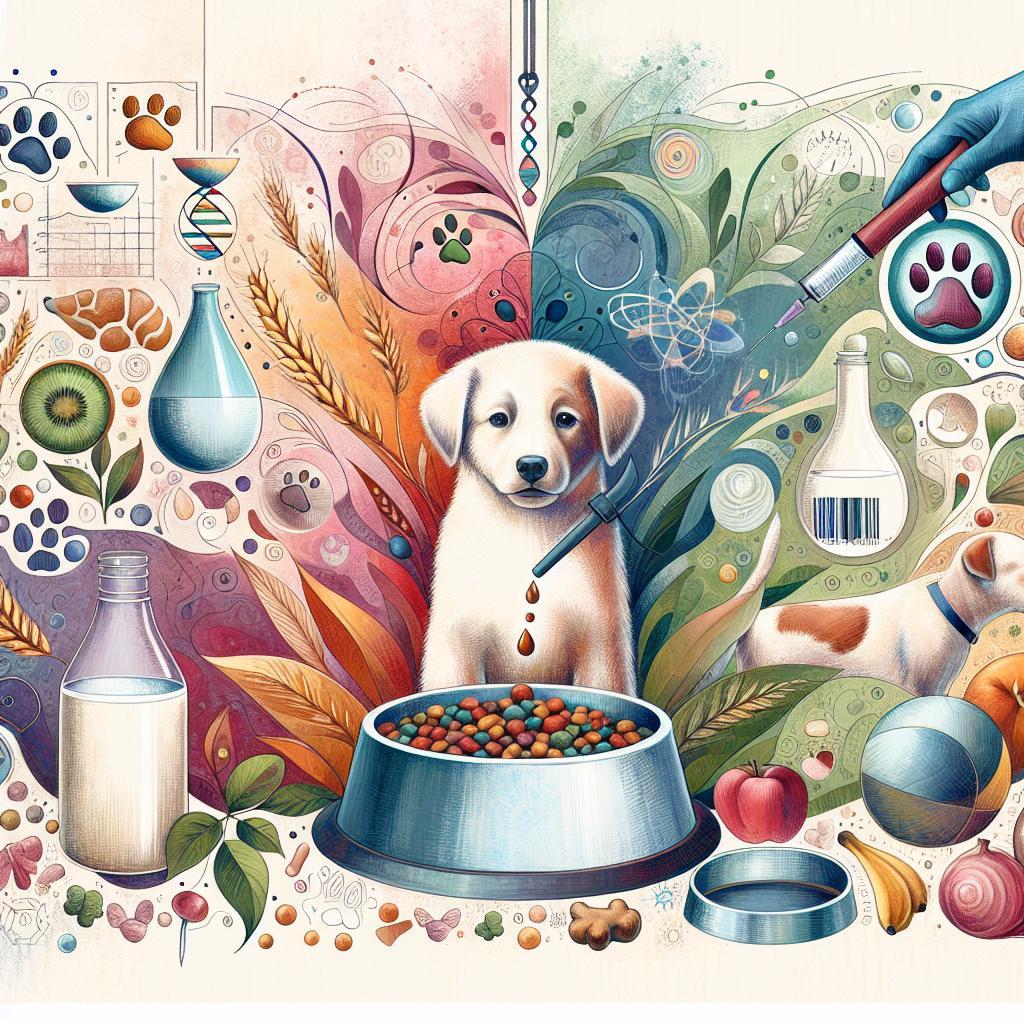Bringing a new litter of puppies into the world is an awe-inspiring journey, filled with joy and challenges alike. For nursing dogs, proper nutrition is paramount to ensure that both mother and her growing pups thrive during this crucial phase. With a sea of dog food options available, selecting the right diet can feel like navigating a maze. It’s not just about feeding; it’s about nourishing a lifeline for nurturing mothers and their rapidly developing offspring. In this article, we will demystify the complex world of dog food for nursing dogs, offering insights and tips to help you make informed choices that will support their health, vitality, and the bond they share with their babies. Get ready to dive into the essentials that will aid in raising strong, healthy pups, starting with the very foundation of their early lives: the food they eat.
Understanding Nutritional Needs of Nursing Dogs
Nursing dogs have unique nutritional requirements that are vital for their health and the well-being of their puppies. During lactation, the caloric needs of a nursing dog increase significantly, often requiring up to twice the daily caloric intake compared to when she is not nursing. It’s essential to focus on high-quality, nutrient-dense dog food that supports both the mother and her growing litter. When selecting the right food, look for formulations that emphasize high protein and fat content, as these components are crucial for the energy needed during this demanding period. Additionally, ensure that the food includes essential vitamins and minerals, such as calcium and phosphorus, which are necessary for the health of both mother and her developing puppies.
Consider the following key nutrients when choosing dog food for nursing dogs:
- Protein: Look for ingredients like chicken, fish, or beef.
- Fats: Healthy fats from fish oil or flaxseed improve overall energy.
- Vitamins: Vitamins A, D, E, and the B-complex group are particularly beneficial.
- Minerals: Ensure a proper balance of calcium and phosphorus.
Using a specially formulated puppy food can be a smart choice, as they often contain higher levels of calories and essential nutrients. Below is a table summarizing the standard nutritional needs:
| Nutrient | Recommended Amount |
|---|---|
| Protein | 22-32% of total calories |
| Fat | 10-25% of total calories |
| Calcium | 1.0-1.8% of diet |
| Phosphorus | 0.8-1.4% of diet |
Evaluating Ingredients for Optimal Health
When selecting food for nursing dogs, it’s essential to scrutinize the ingredients to ensure they provide the necessary nutrients for both the mother and her puppies. Look for high-quality protein sources as the foundation of the diet, such as chicken, lamb, or fish. These proteins are vital in supporting muscle mass and recovery for the nursing mother. Additionally, consider the inclusion of healthy fats, like omega-3 and omega-6 fatty acids, which promote healthy skin and coat, and are crucial for the puppies’ brain development. A few key ingredients to look for include:
- Whole meats or meat meals – Concentrated protein sources.
- Fish oil - Source of omega fatty acids.
- Whole grains – Provide energy and fiber.
- Fruits and vegetables – Rich in vitamins and antioxidants.
Another aspect to consider is the presence of essential vitamins and minerals that support both the nursing mother’s health and the growth of her puppies. Look for a formulation that includes calcium and phosphorous to promote strong bones and teeth. Additionally, B vitamins play a crucial role in energy metabolism and overall health. To visualize the nutritional balance, refer to the following table highlighting key nutrients:
| Nutrient | Importance |
|---|---|
| Protein | Supports recovery and growth. |
| Healthy Fats | Promotes skin health and brain development. |
| Calcium | Essential for bone health. |
| B Vitamins | Boosts energy metabolism. |

Balancing Protein, Fat, and Carbohydrates
Choosing the right balance of macronutrients in your nursing dog’s diet is crucial for both her health and the well-being of her puppies. During lactation, a dog’s energy needs increase significantly, making it essential to provide a diet rich in high-quality protein, healthy fats, and adequate carbohydrates. Each of these components plays a vital role:
- Protein: Essential for milk production, muscle maintenance, and overall growth. Look for sources such as chicken, beef, fish, or lamb.
- Fats: A concentrated source of energy that supports brain development in puppies. Opt for fats from fish oil or chicken fat.
- Carbohydrates: Provide the necessary energy that can be easily digested, with ingredients like brown rice or sweet potatoes being ideal.
To illustrate the importance of macronutrient balance, consider the following table that highlights the recommended proportions in a nursing dog’s diet:
| Macronutrient | Recommended Percentage |
|---|---|
| Protein | 25-30% |
| Fat | 15-20% |
| Carbohydrates | 45-55% |
When selecting commercial dog food, check for these macronutrients on the label. It’s often beneficial to consult with a veterinarian to ensure that your nursing dog receives a tailored diet that meets her specific needs and the demands of her growing puppies. Proper nutrition during this critical time will not only support the mother but also lay a strong foundation for her pups’ health and development.

Choosing Between Dry and Wet Dog Food Options
When selecting the ideal food for nursing dogs, one critical decision is whether to opt for dry (kibble) or wet (canned) dog food. Dry food is often favored for its convenience, longer shelf life, and dental benefits, as the crunchiness can aid in reducing plaque build-up. Additionally, it can be left out throughout the day, allowing nursing mothers to graze as needed. However, nursing dogs require higher moisture content in their diet, which is where wet food shines. Wet food tends to be more palatable and can be easier for dogs to digest, making it a great option for those who may have reduced appetite during the demanding nursing period.
Ultimately, the right choice may depend on individual preferences and the specific nutritional needs of the dog. To make an informed decision, consider the following factors:
- Caloric Density: Wet food generally has higher water content but can provide necessary calories for nursing mothers.
- Ingredients: Look for high-quality protein sources and nutrient-dense ingredients in both types of food.
- Mix and Match: Combine both dry and wet food to create a balanced diet that meets hydration and palatability needs.
- Vet Recommendations: Always consult a veterinarian to ensure that the chosen food meets the specific nutritional requirements for nursing dogs.
Q&A
Q&A: How to Choose the Right Dog Food for Nursing Dogs
Q1: Why is it important to choose the right food for nursing dogs?
A1: Nursing dogs have increased nutritional needs because they are not only feeding their puppies but also recovering from pregnancy. The right food supports their energy levels, milk production, and overall health, ensuring they can provide the best care for their little ones.
Q2: What nutrients should be prioritized in a nursing dog’s diet?
A2: Look for a diet rich in protein to support muscle repair and milk production, healthy fats for energy, and essential vitamins and minerals for overall health. Calcium is especially important for nursing mothers to help with milk supply and maintain bone health.
Q3: Should I change my nursing dog’s food gradually or all at once?
A3: It’s usually best to transition gradually, especially if you’re switching brands or formulas. A sudden change can upset your dog’s stomach, which isn’t ideal during this critical time. Gradually mix in the new food over several days to help them adjust smoothly.
Q4: Are there specific ingredients to avoid in dog food for nursing mothers?
A4: Yes, avoid foods with fillers such as corn and soy, artificial preservatives, and excessive grains. These ingredients offer little nutritional value and may lead to digestive issues. Instead, opt for high-quality, natural ingredients that provide the necessary nutrients.
Q5: Can I feed a nursing dog puppy food instead of adult dog food?
A5: Absolutely! Puppy food is often recommended for nursing mothers because it is formulated to meet higher energy and nutrient needs, making it an excellent choice during this time. It can provide the extra boost they require for milk production and overall health.
Q6: How often should I feed a nursing dog?
A6: Nursing dogs typically require more regular feedings. It’s a good idea to provide meals three to four times a day, as they have increased appetite and energy demands. Ensure they always have access to fresh water, which is crucial for milk production.
Q7: What if my nursing dog refuses to eat?
A7: If your nursing dog isn’t eating, it could be a sign of stress or discomfort. Try offering different food textures, flavors, or warm food to entice her. If she continues to refuse food or shows signs of illness, consult your veterinarian for tailored advice.
Q8: How can I tell if the food I’ve chosen is working for my nursing dog?
A8: Monitor your dog’s energy levels, coat condition, and overall health. A healthy nursing dog should have a shiny coat, a good appetite, and be producing enough milk for her puppies. Regular weight checks can also indicate whether she’s maintaining a healthy weight as she feeds her pups.
Q9: Are there any supplements I should consider for a nursing dog?
A9: While a well-balanced dog food should cover most needs, some owners choose to add supplements like omega fatty acids for a healthy coat or probiotics for digestive health. Always consult with your vet before adding supplements to ensure they’re necessary and safe.
Q10: When should I transition my nursing dog back to her regular diet?
A10: Once the puppies start weaning, usually around four to six weeks old, you can gradually transition your nursing dog back to her regular diet. Pay attention to her body condition and energy levels to make sure the transition is smooth, adjusting as needed based on her specific needs.
Choosing the right dog food for a nursing dog is crucial for their health and performance in caring for their puppies. By prioritizing nutrient-rich, high-quality food and monitoring their well-being, you can help ensure a successful nursing period for both mother and puppies.
The Way Forward
selecting the right dog food for nursing dogs is an essential step in ensuring the health and vitality of both the mother and her puppies. By understanding the unique nutritional needs during this critical period, you can provide the best support for her recovery and the proper growth for her litter. Remember to prioritize high-quality ingredients, consult with your veterinarian, and pay close attention to your dog’s individual needs and preferences. As you embark on this journey of nurturing a thriving family, keep in mind that your careful choices will lay the foundation for a healthy, happy start to their lives. With the right nourishment, you can rest assured that both mother and pups will flourish, creating a joyful and vibrant atmosphere in your home. Happy feeding!

